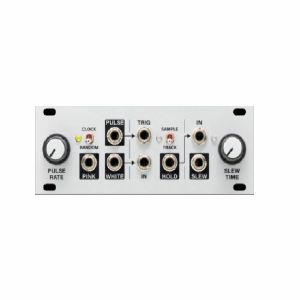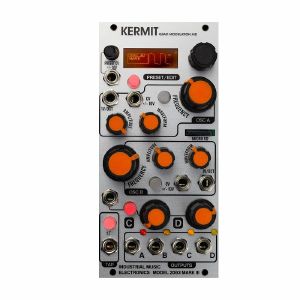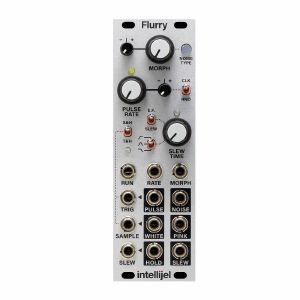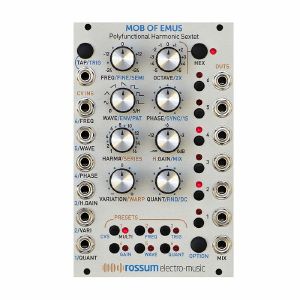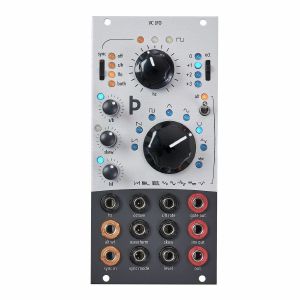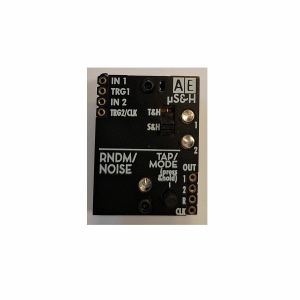Filter
Equipment
Format
Featured
Price
Tags: Random module
Products tagged as Random module
Artikel 1 bis 6 von 6 auf Seite 1 von 1 anzeigen
Intellijel Noise Tools 1U Clock/Random Pulse/Analogue Noise/Sample & Hold/Slew Module (clock generator/noise/random/sample & hold/slew limiter synth module)
Cat: 643383 Rel: 27 Mar 17
Utility module featuring Clock, Random Pulse, Analog Noise, Sample/Hold & Slew
Notes: Noise Random Tools comprises a collection of useful utility blocks that you could use in many of your patches - Clock, Random Pulse, Analog Noise, Sample and Hold, and Slew.
Features:
- Clock and Random pulse source with adjustable rate
- Analog pink and white noise source with very accurate spectrum
- Analog sample / track and hold with very low droop
- Analog slew with adjustable slew rate
… Read moreFeatures:
- Clock and Random pulse source with adjustable rate
- Analog pink and white noise source with very accurate spectrum
- Analog sample / track and hold with very low droop
- Analog slew with adjustable slew rate
1 in stock $111.74
Click for better price!
or call +44 20 7424 1960
quote 643383
quote 643383
Industrial Music Electronics Kermit Mark III Quad Modulation Aid Module (modulation synth module)
Cat: 757220 Rel: 01 Apr 20
4-channel programmable supermodulator module - 12HP
Notes: Kermit is a 4-channel programmable supermodulator with morphing wavetable generator and internal modulation matrix. Four channels operate as LFOs, audio rate oscillators (with 1v/octave response on two channels), 1-shot envelopes, random voltage generators, or sample-and-holds, all responding to manual control, external control voltages, or synchronization to the module's master tap tempo clock. Designed for maximum patching power in small systems, Kermit carries an unmatched functionality-per-HP factor with an easily readable display that shows parameters in their real-world units.
The module has a 16-bit DAC to accurately render subtle changes of voltage at extremely low frequencies. The oscillator mode is best suited for bass frequencies, and the waveform "character" modes restrict the morph behavior or degenerate the audio to a minimum of 8 bits with limited horizontal resolution, like the Konami SCC chip used with the MSX computer. The tap tempo facility features an input jack and a manual button. The tempo is shown on the OLED display in BPM. The relevant units (hertz, seconds, volts, etc) or selected waveform of each channel are contextually shown on the display as the user programs the module.
List of operating modes per channel:
LFO (1 volt/octave)
LFO (with reset)
Tap tempo LFO
Audio oscillator
Audio oscillator (unison)
Code scan
1-shot envelope
Gated repeat envelope
Tap tempo envelope
Smooth random
Stepped random
Tap tempo stepped random
Sample-and-hold
Track-and-hold
Tap Tempo sample-and-hold
Three parameters on each channel can be modulated: frequency, amplitude, or waveform. Both external CV input and internal cross modulation are programmable with hotkeys. For example: assign the output of Channel B to morph the waveform of Channel A by holding the Channel B button while turning the Channel A Waveform knob. All channels have manual control of frequency (coarse and fine), phase, wave bank, waveform morph, and amplitude. Channels A and B have full controls, C and D have single knob controls with deep parameters accessible by hotkey combinations. Still deeper functions are accessible through the Mark III menu system.
Kermit has a microSD card slot for loading custom waveforms, like its big brother Piston Honda. The SD card accepts one .WAV file in WaveEdit format (free software editor) containing 64 waveforms, also compatible with several other Eurorack modules. When loaded into Kermit, the waveforms are organized into 8 banks of 8 waveforms each. Each oscillator can select any of the 8 banks, and the 8 constituent waves can be smoothly morphed from one to another.
The Mark III morphing preset manager is in full effect on Kermit. The discrete preset mode quickly and reliably recalls all parameters in response to triggers or CV, accessing the true power of the module as detailed, carefully programmed settings are effortlessly loaded and changed. The morphing mode causes delightfully unexpected variations of the basis preset.
Insert a master clock signal and you're ready to go. Kermit is a reliable provider of endless rhythmically coherent modulation voltages and a reasonably competent "voice module" providing most common synthesis functions on each channel with an internal modulation matrix.
… Read moreThe module has a 16-bit DAC to accurately render subtle changes of voltage at extremely low frequencies. The oscillator mode is best suited for bass frequencies, and the waveform "character" modes restrict the morph behavior or degenerate the audio to a minimum of 8 bits with limited horizontal resolution, like the Konami SCC chip used with the MSX computer. The tap tempo facility features an input jack and a manual button. The tempo is shown on the OLED display in BPM. The relevant units (hertz, seconds, volts, etc) or selected waveform of each channel are contextually shown on the display as the user programs the module.
List of operating modes per channel:
LFO (1 volt/octave)
LFO (with reset)
Tap tempo LFO
Audio oscillator
Audio oscillator (unison)
Code scan
1-shot envelope
Gated repeat envelope
Tap tempo envelope
Smooth random
Stepped random
Tap tempo stepped random
Sample-and-hold
Track-and-hold
Tap Tempo sample-and-hold
Three parameters on each channel can be modulated: frequency, amplitude, or waveform. Both external CV input and internal cross modulation are programmable with hotkeys. For example: assign the output of Channel B to morph the waveform of Channel A by holding the Channel B button while turning the Channel A Waveform knob. All channels have manual control of frequency (coarse and fine), phase, wave bank, waveform morph, and amplitude. Channels A and B have full controls, C and D have single knob controls with deep parameters accessible by hotkey combinations. Still deeper functions are accessible through the Mark III menu system.
Kermit has a microSD card slot for loading custom waveforms, like its big brother Piston Honda. The SD card accepts one .WAV file in WaveEdit format (free software editor) containing 64 waveforms, also compatible with several other Eurorack modules. When loaded into Kermit, the waveforms are organized into 8 banks of 8 waveforms each. Each oscillator can select any of the 8 banks, and the 8 constituent waves can be smoothly morphed from one to another.
The Mark III morphing preset manager is in full effect on Kermit. The discrete preset mode quickly and reliably recalls all parameters in response to triggers or CV, accessing the true power of the module as detailed, carefully programmed settings are effortlessly loaded and changed. The morphing mode causes delightfully unexpected variations of the basis preset.
Insert a master clock signal and you're ready to go. Kermit is a reliable provider of endless rhythmically coherent modulation voltages and a reasonably competent "voice module" providing most common synthesis functions on each channel with an internal modulation matrix.
4 in stock $464.68
Click for better price!
or call +44 20 7424 1960
quote 757220
quote 757220
Intellijel Flurry Clock/Random Pulse Source Module (clock generator/random synth module)
Cat: 936173 Rel: 28 Mar 23
Clock, random pulse source module in 8HP.
Notes: A multi-purpose module designed to combine noise and modulation sources, slew, sample-and-hold, envelope following and more. Extremely versatile way to add randomness and controlled movement to patches.
Supplier's Notes:
Flurry collects and connects a number of practical modular synthesis tools, focused on clocks, noises, and randomness to create a module that is rife with opportunities for exploration and experimentation. Equally capable as a synthesis source, modulator, clock, or signal modifier; It is bound to find a way to bring new life and dimensions to your synth patches.
Core Functions:
A clock and random pulse source with adjustable and modulatable rate
Accurate pink and white noise sources
Analogue sample & hold and track & hold circuits with very low droop
Analogue slew with adjustable slew time and edge selection (rising edge, falling edge, or both)
Envelope follower
16 noise synthesis algorithms, each with 2 parameters.
One of Flurry's more interesting aspects is its collection of digital noises, which provide a wealth of interesting noises, suitable for either audio or modulation purposes. Each noise type has its own pair of unique parameters to further dial in the desired characteristics, with the primary parameter under CV control.
Most people consider noise to be "undesirable," and product developers expend great effort to design circuits that minimize noise. So why make a module designed specifically to create noise?
Indeed, unwanted noise is undesirable. But not all noise is unwanted. Synthesizing the sound of wind or waves are a couple of the more obvious uses for a noise generator, but the possibilities go far beyond. The crack of a snare hit; the breathiness of a flute sound; an added sizzle to a resonant pad - all are within the sonic domain of noise.
But noise has many other benefits beyond simply being heard. Noise happens to make a wonderful modulator. When noise is used to modulate a filter's cutoff frequency, or an oscillator's pitch or pulse width, then all sorts of raspy, buzzy, gritty timbres are obtained.
Noise is also a key ingredient in sample & hold circuits - a technique most commonly used to generate stepped, random voltages. The circuit works by sampling an input signal's voltage each time you send it a clock pulse, and holding that voltage until the next clock pulse. So, naturally, Flurry also contains the requisite clocking tools! Two of the most common destinations for the S&H output are a filter's cutoff frequency (creating stepped, clocked timbral changes), and oscillator pitch (which produces random notes at clocked intervals).
Of course, you might not always want your voltages to change so abruptly at each clock pulse. Maybe you'd prefer they wobble about gradually and with more grace? To do that, you need a slew circuit, and once again Flurry has you covered - allowing you to select not just the slew time, but also whether the slew is applied to rising voltages, falling voltages, or both. A flick of the switch, and that Slew circuit becomes an envelope follower, enabling Flurry to generate envelopes from input signals (syncing to drum hits are a common use).
With all these features, plus the ability to create random pulses, clock to external pulses, and perform more esoteric track & hold duties, Flurry is a noise lover's toolbox.
Width: 8HP
Depth: 34mm
Power: 116mA @ +12V 30mA @ -12V
… Read moreSupplier's Notes:
Flurry collects and connects a number of practical modular synthesis tools, focused on clocks, noises, and randomness to create a module that is rife with opportunities for exploration and experimentation. Equally capable as a synthesis source, modulator, clock, or signal modifier; It is bound to find a way to bring new life and dimensions to your synth patches.
Core Functions:
A clock and random pulse source with adjustable and modulatable rate
Accurate pink and white noise sources
Analogue sample & hold and track & hold circuits with very low droop
Analogue slew with adjustable slew time and edge selection (rising edge, falling edge, or both)
Envelope follower
16 noise synthesis algorithms, each with 2 parameters.
One of Flurry's more interesting aspects is its collection of digital noises, which provide a wealth of interesting noises, suitable for either audio or modulation purposes. Each noise type has its own pair of unique parameters to further dial in the desired characteristics, with the primary parameter under CV control.
Most people consider noise to be "undesirable," and product developers expend great effort to design circuits that minimize noise. So why make a module designed specifically to create noise?
Indeed, unwanted noise is undesirable. But not all noise is unwanted. Synthesizing the sound of wind or waves are a couple of the more obvious uses for a noise generator, but the possibilities go far beyond. The crack of a snare hit; the breathiness of a flute sound; an added sizzle to a resonant pad - all are within the sonic domain of noise.
But noise has many other benefits beyond simply being heard. Noise happens to make a wonderful modulator. When noise is used to modulate a filter's cutoff frequency, or an oscillator's pitch or pulse width, then all sorts of raspy, buzzy, gritty timbres are obtained.
Noise is also a key ingredient in sample & hold circuits - a technique most commonly used to generate stepped, random voltages. The circuit works by sampling an input signal's voltage each time you send it a clock pulse, and holding that voltage until the next clock pulse. So, naturally, Flurry also contains the requisite clocking tools! Two of the most common destinations for the S&H output are a filter's cutoff frequency (creating stepped, clocked timbral changes), and oscillator pitch (which produces random notes at clocked intervals).
Of course, you might not always want your voltages to change so abruptly at each clock pulse. Maybe you'd prefer they wobble about gradually and with more grace? To do that, you need a slew circuit, and once again Flurry has you covered - allowing you to select not just the slew time, but also whether the slew is applied to rising voltages, falling voltages, or both. A flick of the switch, and that Slew circuit becomes an envelope follower, enabling Flurry to generate envelopes from input signals (syncing to drum hits are a common use).
With all these features, plus the ability to create random pulses, clock to external pulses, and perform more esoteric track & hold duties, Flurry is a noise lover's toolbox.
Width: 8HP
Depth: 34mm
Power: 116mA @ +12V 30mA @ -12V
1 in stock $263.32
Click for better price!
or call +44 20 7424 1960
quote 936173
quote 936173
Rossum Electro-Music Mob Of Emus Polyfunctional Harmonic Sextet Module (envelope generator/LFO/oscillator/quantiser/sample & hold/CV modulation/digital/random synth module)
Cat: 797062 Rel: 25 Nov 20
Polyfunctional harmonic sextet module
Notes: *** Free software update available as a free download, along with updated documentation, at the Mob of Emus product page on the Rossum Electro-Music website***
A lot to unpack here. Six-channel multipurpose oscillator/noise source/modulation generator with quantisation, trigger generators and even more. Seriously powerful all-round digital goodness.
Supplier's Notes:
Mob of Emus is a powerful music and sound design tool that packs an enormous amount of creative power into an amazingly compact 16HP module.
Mob of Emus gives you six channels of oscillators, noise sources, cyclical and 1-shot modulators (including LFOs, envelopes, and various other shapes), sample and hold waveshapes, slow random modulators, triggers, rhythm patterns, and quantization (of both internal and external signals) in pretty much any combination (well, any combination of six channels, anyway).
In addition to being able to independently program the function of each individual channel, Mob of Emus' Hex Mode provides a macro control layer that allows you to control all of its channels simultaneously (while maintaining the relationships of each channel's independent programming).
What's more, Mob of Emus' "harmonic" control structure makes it extremely easy to combine its oscillators into rich additive timbres, to combine its LFOs into stacked harmonic low frequency modulation waves, and to create modulation sources and triggers with intricate polyrhythmic patterns.
With an external trigger input, six CV inputs that can operate in six different control modes, six independent outputs, and an assignable mix output, Mob of Emus can operate as the heart of an almost unlimited variety of patches. And its 8 real-time controls will give you immediate hands-on access to a channel's (or all six channels') key parameters, inviting (and rewarding) exploration and improvisation.
Mob of Emus features include:
Six channels that can function independently or can be further controlled by a Hex Mode macro layer that lets you control all six simultaneously. Channels can be:
Wide-range digital oscillators
Noise sources
Cyclical and 1-shot modulators (including LFOs, envelopes, and various other shapes)
Sample and hold waveshapes
Slow random modulators
Triggers
Rhythm patterns
Quantizers (of both internal and external(!) signals)
Six CV inputs that can function in six different control modes
Eight real-time controls for immediate access to key channel parameters
Six individual channel outputs and an assignable mix output
The ability to store and recall 12 user presets
And much more.
Mob of Emus is 16HP wide and 25mm deep.
Power requirements (max): 130mA +12V, 25mA -12V. Reverse polarity protected.
As of March 2021, there has been a been a small bug fix to the recent software update for Mob of Emus.
The update fixes a bug where holding the Channel Selector Buttons for a short time to select a single channel and deselect any others was not working correctly.
The update fixes a bug where some Hex Mode parameters were not ignored when Hex Mode was set to off.
The update introduces a feature allowing users to double-click and hold the Hex button to reset all Hex Mode parameters and set Hex Mode to on.
Rossum Electro-Music made a change to the behavior of the LEDS when using the utility 'Display Software Revision'
… Read moreA lot to unpack here. Six-channel multipurpose oscillator/noise source/modulation generator with quantisation, trigger generators and even more. Seriously powerful all-round digital goodness.
Supplier's Notes:
Mob of Emus is a powerful music and sound design tool that packs an enormous amount of creative power into an amazingly compact 16HP module.
Mob of Emus gives you six channels of oscillators, noise sources, cyclical and 1-shot modulators (including LFOs, envelopes, and various other shapes), sample and hold waveshapes, slow random modulators, triggers, rhythm patterns, and quantization (of both internal and external signals) in pretty much any combination (well, any combination of six channels, anyway).
In addition to being able to independently program the function of each individual channel, Mob of Emus' Hex Mode provides a macro control layer that allows you to control all of its channels simultaneously (while maintaining the relationships of each channel's independent programming).
What's more, Mob of Emus' "harmonic" control structure makes it extremely easy to combine its oscillators into rich additive timbres, to combine its LFOs into stacked harmonic low frequency modulation waves, and to create modulation sources and triggers with intricate polyrhythmic patterns.
With an external trigger input, six CV inputs that can operate in six different control modes, six independent outputs, and an assignable mix output, Mob of Emus can operate as the heart of an almost unlimited variety of patches. And its 8 real-time controls will give you immediate hands-on access to a channel's (or all six channels') key parameters, inviting (and rewarding) exploration and improvisation.
Mob of Emus features include:
Six channels that can function independently or can be further controlled by a Hex Mode macro layer that lets you control all six simultaneously. Channels can be:
Wide-range digital oscillators
Noise sources
Cyclical and 1-shot modulators (including LFOs, envelopes, and various other shapes)
Sample and hold waveshapes
Slow random modulators
Triggers
Rhythm patterns
Quantizers (of both internal and external(!) signals)
Six CV inputs that can function in six different control modes
Eight real-time controls for immediate access to key channel parameters
Six individual channel outputs and an assignable mix output
The ability to store and recall 12 user presets
And much more.
Mob of Emus is 16HP wide and 25mm deep.
Power requirements (max): 130mA +12V, 25mA -12V. Reverse polarity protected.
As of March 2021, there has been a been a small bug fix to the recent software update for Mob of Emus.
The update fixes a bug where holding the Channel Selector Buttons for a short time to select a single channel and deselect any others was not working correctly.
The update fixes a bug where some Hex Mode parameters were not ignored when Hex Mode was set to off.
The update introduces a feature allowing users to double-click and hold the Hex button to reset all Hex Mode parameters and set Hex Mode to on.
Rossum Electro-Music made a change to the behavior of the LEDS when using the utility 'Display Software Revision'
1 in stock $434.90
Thorn Audio VC LFO Voltage Controlled Low Frequency Oscillator Module (silver/black) (LFO synth module)
Cat: 832527 Rel: 02 Jul 21
Voltage controlled low frequency oscillator module - 12HP
Notes: A deep, comprehensive digital LFO offering 16 waveforms, sync, built-in VCA and more. All made even more powerful by the fact you can control every parameter via dedicated CV inputs.
Supplier's Notes:
Fully voltage controllable Eurorack format, externally syncable, 16 waveform low frequency oscillator with built-in VCA and sample & hold.
Powered by a socketed VCLFO10 IC from Electric Druid.
The core idea behind this module is all about control voltage. Hence all features are individually broken out to CV inputs, making the most use possible of the benefits of the digital wavetable oscillator. This means that the design is geared towards allowing hands-off control of all aspects and some concessions have been made to that effect.
Initial setup basically consists of connecting the power cable to the module and your bus. The cable has a slotted socket for correct orientation, but mind that the red stripe faces the white line on the edge of the pcb. The included screws are nylon in order to minimise rack-rash.
Tuning the module is possible by adjusting the small smd trim potentiometer on the back. It adjusts the offset voltage that affects the center point of the lfo oscillations. It should be close to its three o'clock position, but you can adjust it by turning the module on, reducing the output level to almost zero and turning the trim potentiometer until you find the point where the gate output led just barely turns off.
The LFO sync type is hard sync, meaning that it resets the current cycle to the beginning of the waveform. It does not control the duration of the cycles. This allows you to further shape the output to, say, three quarters of a sinewave by using external sync and adjusting the HZ knob so the duration of a cycle is just a little longer than the time between incoming sync pulses.
Color coded nuts indicate the type of jack, with gold representing Gate/Trigger input, black is +-5v CV inputs and red jacks are outputs.
The CV inputs are scaled down to +-2.5v and added/subtracted with the knob setting, meaning that to sweep the full range of the parameter with CV, the knob should be in center position. The inputs are clipped to the allowed range after mixing, so you can apply any eurorack voltage here.
The module's core processor is socketed, so using a simple PIC programmer and some basic Assembly knowledge you can modify its functionality to suit your needs.
The code is written by Electric Druid who supplies the chips preprogrammed.
Height: 3U (128.5mm)
Width: 12hp (60.6mm)
Depth from panel: 31mm
Depth total: 51mm
+12v: 80mA
-12v: 60mA
… Read moreSupplier's Notes:
Fully voltage controllable Eurorack format, externally syncable, 16 waveform low frequency oscillator with built-in VCA and sample & hold.
Powered by a socketed VCLFO10 IC from Electric Druid.
The core idea behind this module is all about control voltage. Hence all features are individually broken out to CV inputs, making the most use possible of the benefits of the digital wavetable oscillator. This means that the design is geared towards allowing hands-off control of all aspects and some concessions have been made to that effect.
Initial setup basically consists of connecting the power cable to the module and your bus. The cable has a slotted socket for correct orientation, but mind that the red stripe faces the white line on the edge of the pcb. The included screws are nylon in order to minimise rack-rash.
Tuning the module is possible by adjusting the small smd trim potentiometer on the back. It adjusts the offset voltage that affects the center point of the lfo oscillations. It should be close to its three o'clock position, but you can adjust it by turning the module on, reducing the output level to almost zero and turning the trim potentiometer until you find the point where the gate output led just barely turns off.
The LFO sync type is hard sync, meaning that it resets the current cycle to the beginning of the waveform. It does not control the duration of the cycles. This allows you to further shape the output to, say, three quarters of a sinewave by using external sync and adjusting the HZ knob so the duration of a cycle is just a little longer than the time between incoming sync pulses.
Color coded nuts indicate the type of jack, with gold representing Gate/Trigger input, black is +-5v CV inputs and red jacks are outputs.
The CV inputs are scaled down to +-2.5v and added/subtracted with the knob setting, meaning that to sweep the full range of the parameter with CV, the knob should be in center position. The inputs are clipped to the allowed range after mixing, so you can apply any eurorack voltage here.
The module's core processor is socketed, so using a simple PIC programmer and some basic Assembly knowledge you can modify its functionality to suit your needs.
The code is written by Electric Druid who supplies the chips preprogrammed.
Height: 3U (128.5mm)
Width: 12hp (60.6mm)
Depth from panel: 31mm
Depth total: 51mm
+12v: 80mA
-12v: 60mA
2 in stock $202.46
Tangible Waves AE Modular uS&H/RANDOM/NOISE Sample & Hold/Noise/ Random Pulses Generator Module (1U modular synthesiser)
Cat: 1012371 Rel: 07 Aug 24
Sample & hold, noise & random pulses generator module - 1U
Notes: The uS&H / RANDOM / NOISE module combines several functionalities for (pseudo) random control; it includes two sample & holds (one of them can be switched to track & hold) and a random/noise section. The latter can be switched between two types of random CV (stepped / smoothed), these either at an internal, tapped rate or an external clock.
Please note: These micro modules need a carrier, like the uBASE module. They cannot be mounted directly into an AE case.
… Read morePlease note: These micro modules need a carrier, like the uBASE module. They cannot be mounted directly into an AE case.
1 in stock $52.83
Click for better price!
or call +44 20 7424 1960
quote 1012371
quote 1012371
Artikel 1 bis 6 von 6 auf Seite 1 von 1 anzeigen

 USD
USD





